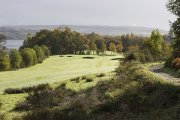Episode 1
Episode 1: Mesolithic hunter-gatherers
Loch Lomond was formed by glaciers that gouged out a deep valley during the last Ice Age. After the end of the Ice Age (around 12,000 years ago), sea levels rose because of the melting ice, and the sea flooded the valley left behind by the ice. However, a brief readvance of the glaciers around 11,000 to 10,000 years ago raised the outlet of the loch, turning it into a freshwater loch. The shores of the loch would have been covered initially with a thin woodland of birch and hazel, which would have progressively matured over hundreds and thousands of years into a rich oak woodland, with a similarly rich fauna.
The GUARD excavations suggested that people visited this part of the loch side soon after the retreat of the ice, during the Mesolithic period. Most evidence from this period consists of pits of differing sizes and functions (remains of dwellings, fire pits, rubbish pits…), with various things found in them. The overall conclusions were that groups of hunter-gatherer people camped or maybe lived here over a period of about 4,000 years, from around 10,000 to 6,000 years ago. Radiocarbon dating of finds, together with evidence from the levels of soil they were found in, suggests that there were three different stages of activity, all around the same part of the site. Maybe this area was particularly attractive because it was a clearing in the woodland?
The earliest evidence (10,200 to 9,500 years ago) included a large pit that may have been part of a sunken dwelling, which yielded burnt hazelnut shells and oak charcoal, and the remains of burnt flint tools. The ‘dwellings’ would likely have been a bit like tents, with animal hide and/or vegetation covering a framework of wooden supports. Other smaller pits also contained flint and chert tools and fragments, as well as more hazelnuts and oak and cherry charcoal. This builds up a picture of small groups of people setting up temporary camps amidst woodland with hazel, oak and cherry trees, and sitting around small fires to knap their stone tools and cook whatever meat and fish they had managed catch with them. We wonder where they got their flint from?
A little later in the Mesolithic (9,500 to 8,500 years ago), even more pits suggested that more people were using the area. More burnt hazelnut shells were found, and charcoal included the remains of willow, hazel, alder, oak, cherry, elm and birch, as well as Scots pine, and possible signs of rowan and wild rose, indicating a very varied woodland. The larger fire pits suggest that maybe larger groups of people lived here, or maybe smaller groups came together around the fires to feast. Again, some of the pits also contained signs of stone tool making, including microliths and debris. We don’t have any evidence of what meat they were hunting and cooking - maybe deer or wild boar, and maybe salmon from the loch? Did they have boats? We don’t know, but evidence of Mesolithic people on islands in other parts of Scotland suggest that they could almost certainly make boats. Interestingly, signs of heat-affected stones near the fire pits suggest that maybe they had been used to heat water for cooking. Stake and post holes, which may have been used to support roofs, provided evidence of possibly three sunken dwellings, which may have made use of the hollows left by the roots of fallen trees. Overall, the layouts of the pits suggested that the people separated their different activities into different areas.
There seemed to be much less activity during the last phase of Mesolithic occupation, from 8,500 to 6,000 years ago, with just four small pits containing fire-cracked stones and charcoal. Importantly, a brief rise in sea levels meant that Loch Lomond became flooded by the sea again for a while around this time, which no doubt also flooded or changed the nature of much of the nearby woodland, maybe making it a less attractive area for hunting. Interestingly, the recent excavations at Succoth carried out by Argyll Archaeology found evidence of hunter-gatherers at the head of Loch Long during this Late Mesolithic period. See a summary of those findings here.
Check out an interesting, general summary of Mesolithic lifestyles here.
Ready for Episode 2? Click here.
Blog
Click on the link here to check out our Facebook page.
Events
Click here to find out about forthcoming events and how to get involved.
Timeline
Click here to see our timeline of events.
Location
Click here to find out where the Hidden Heritage Project is taking place.
Contact Us
Click here for our contact details.








